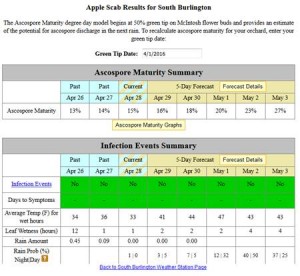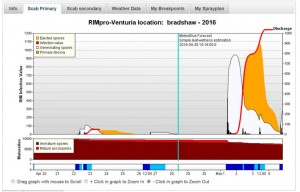Even with the best expert systems, on-farm weather stations, and predictive forecasts, sometimes we have to rely on common sense when making management decisions in the orchard. The forecast for most of Vermont is for rain showers to begin Sunday, with higher likelihood in southern Vermont. By Monday, we’re looking at 50-60% chances. With average temperatures around 50°F, we only need 11 hours leaf wetness to cause an infection, and at 57° that lowers to seven hours. Primary ascospore maturity is estimated at around 25% by Sunday, which presents a very good load of inoculum for infection.
However, NEWA is not predicting an infection period for this weather event. (You’ll notice an April 1 date entered for green tip, I did this to be conservative in estimating ascospore maturity development to reflect the weather in early April conducive to spore maturation which has a base temperature of 32°F vs 43° or so for tree bud stage development).
On the other hand, I am running a trial of another proprietary modelling system from Europe, RIMpro, which uses a different forecast model and predicts a pretty significant infection event:
I am only running this at two sites in the state and don’t have the ability to make it ‘live’, so I’m using it as supplemental to NEWA for now. The graph has a lot of information: rain and leaf wetness at the bottom in blue, and various stages of spore release, germination, and development in the curves above the maturation chart. The red “infection value” line represents the overall risk for infection, and anything over 300 is considered a severe infection risk in unprotected orchards. The white portion of the curve represents germinating spores that may be susceptible to contact fungicides, the orange curve represents spores that have developed primary stroma into leaf tissue and the beginning of ‘infection’.
Since we’re pretty early in our use and interpretation of this system, and it is all based on predictive weather data ay our specific site in South Burlington anyway, please don’t take the model as indicative of actual orchard conditions yet. That said, there appears to be good likelihood of a potentially severe infection period starting Monday. In general, calm winds are expected over the weekend so there should be ample time to get a protective spray on. However, overnight and early morning temperatures are expected to be below freezing, so follow the usual precautions: no oil application, avoid captan as well if possible, and protect pumps, booms, and lines from freezing.


